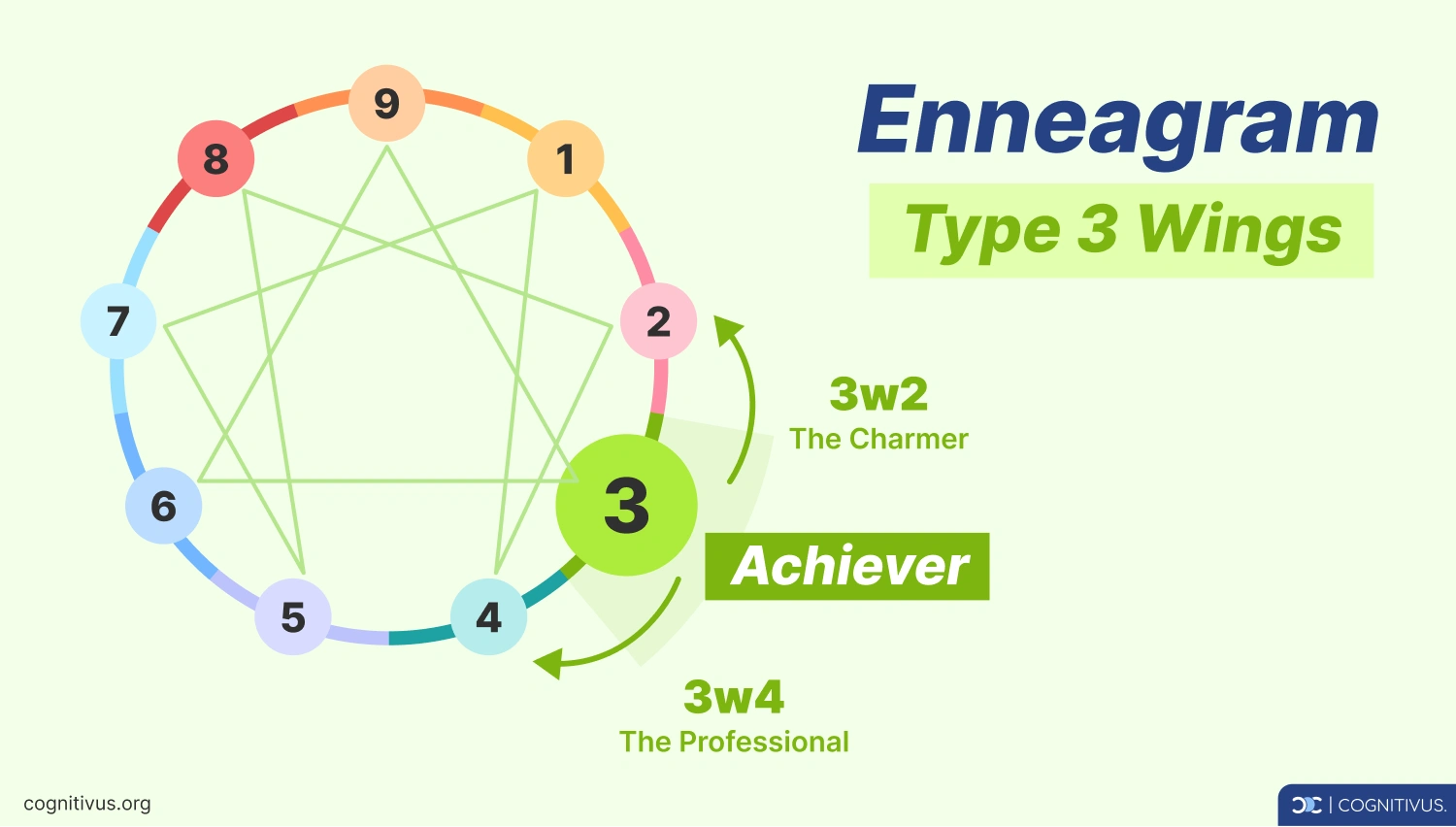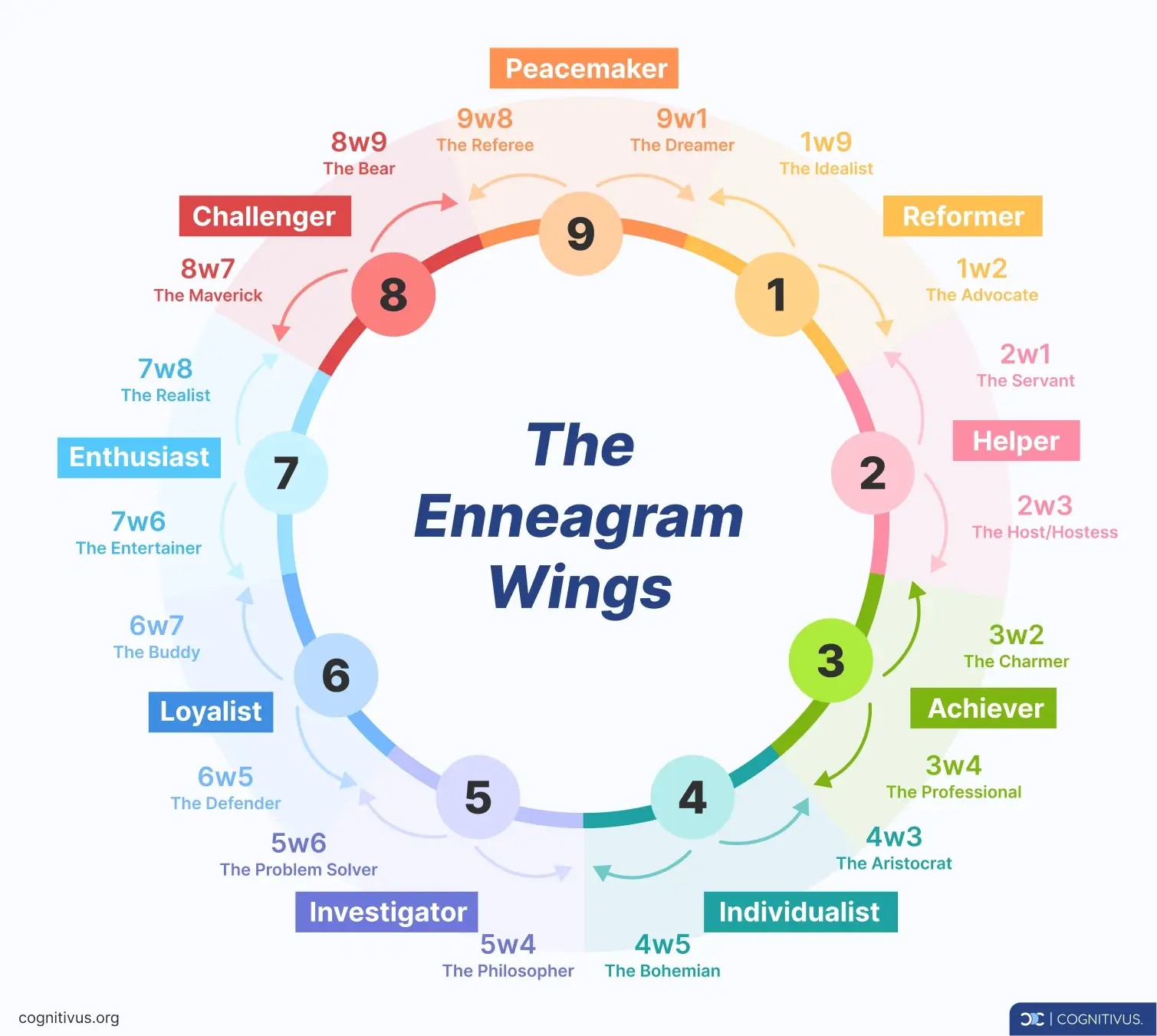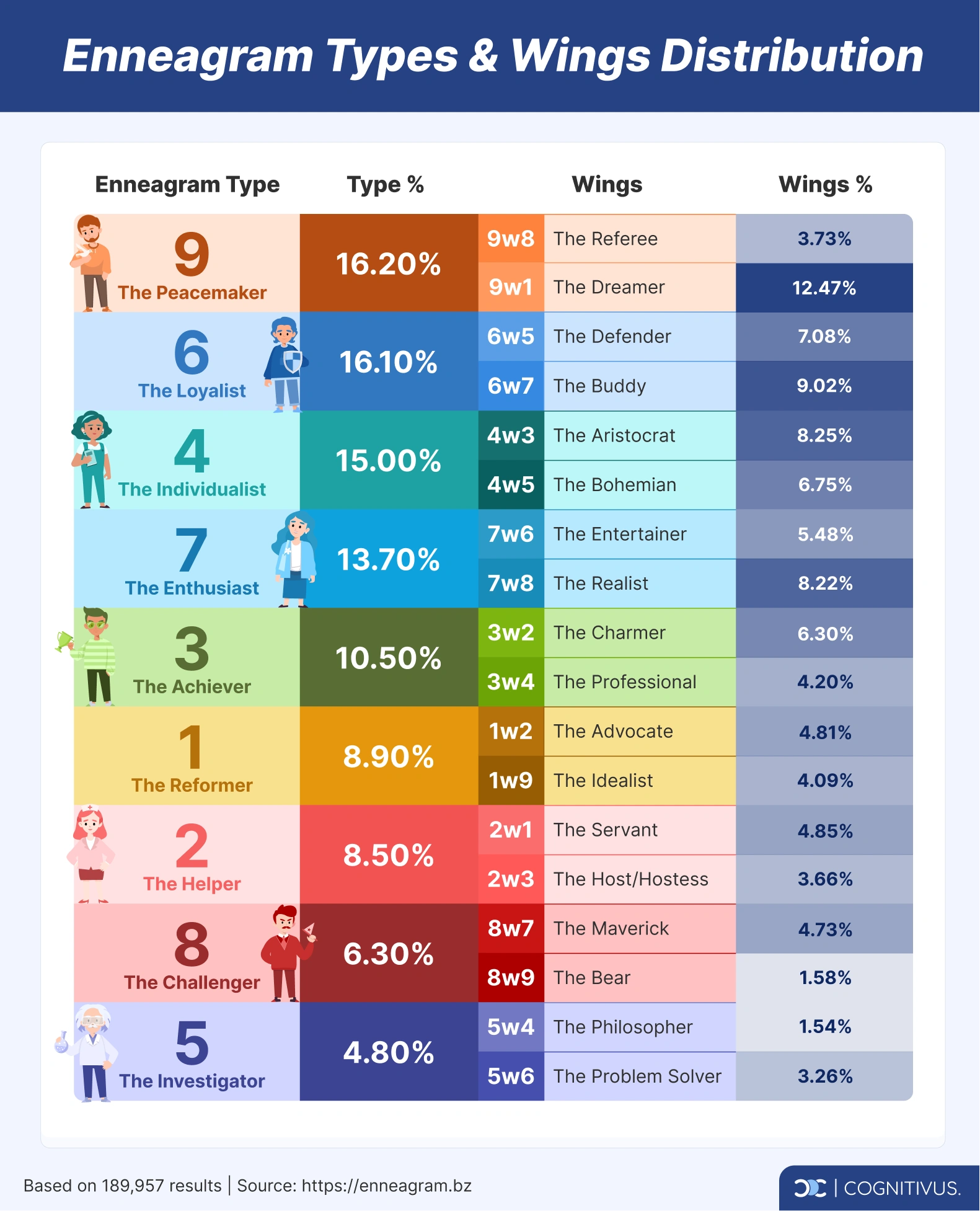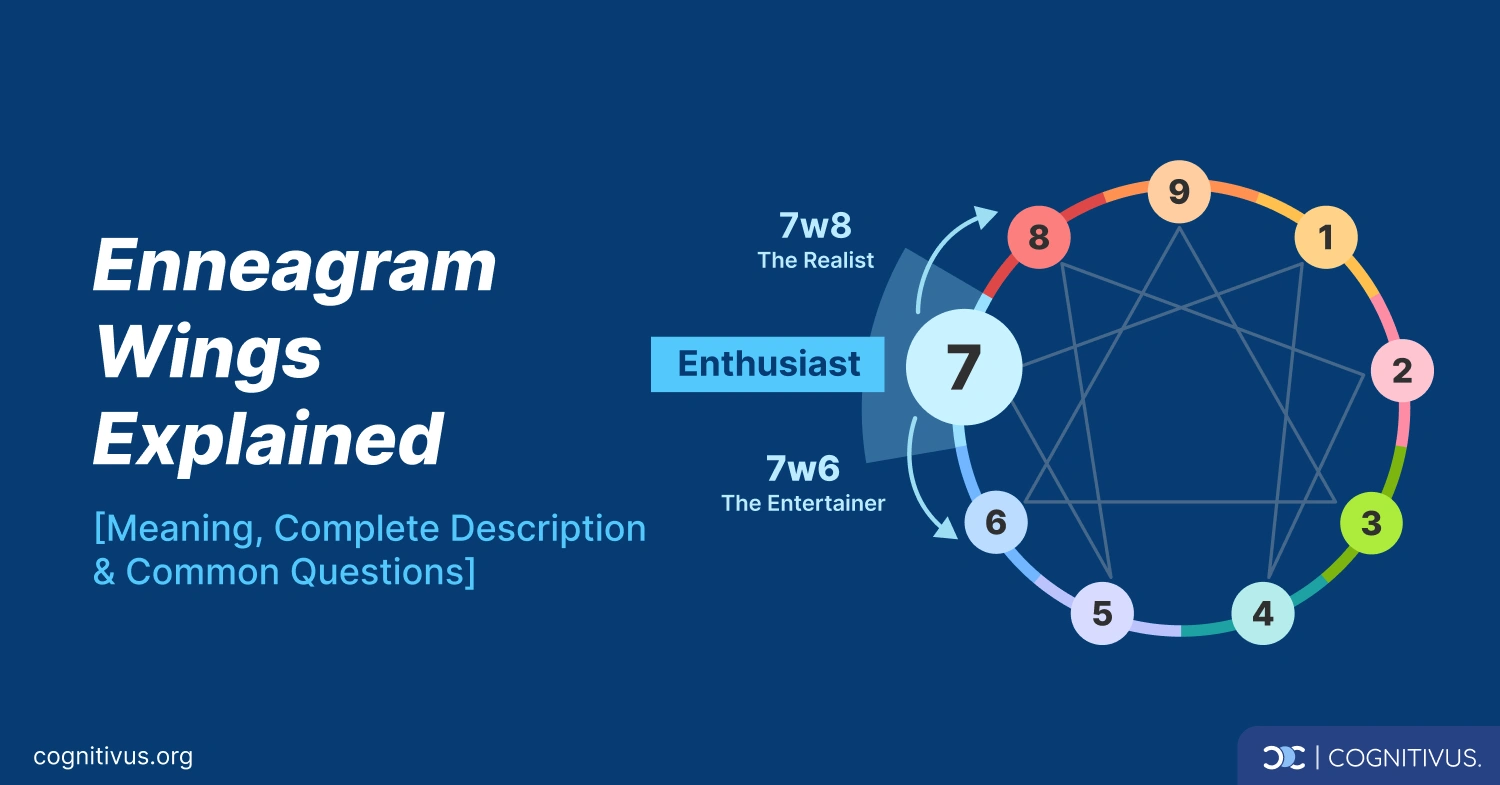The Enneagram provides profound insights into your personality. By understanding your Enneagram wings, you can gain even deeper self-awareness. In this guide, we'll explore what Enneagram wings are, how to identify yours, and how they can help you grow.
What Is the Enneagram and What Are Wings?
The Enneagram
The Enneagram is a powerful tool for understanding personality types. It consists of nine core types, each representing a distinct set of motivations, fears, and desires. Think of your core type as the foundation of your personality.
What do the Enneagram wings mean?
The Enneagram wings are the types next to your core type on the Enneagram wheel. They add extra flavor and depth to your core personality, influencing how you express your traits.
For example, if your core Enneagram type is a 1 (the Perfectionist, also called the Reformer), your wings would be 9 and 2.
Usually, one wing has a stronger influence, adding unique nuances to your behavior and outlook. A type 1 with a 2 wing (abbreviated "1w2" and called “the Advocate”) is typically more helpful and supportive, while a type 1 with a 9 wing (abbreviated "1w9" and called “the Idealist”) is generally more peaceful and composed.
Psychiatrists like Morgan Alexander, B.S., and Brent Schnipke, M.D., see the Enneagram, including wings, as valuable for understanding motivations and behaviors. It complements other personality models, offering deeper insights into why we act the way we do.
What Is the Difference Between Wing and Core Enneagram?
Your core Enneagram type is the primary framework of your personality. It defines your main motivations and fears. Wings, on the other hand, are the neighboring types that influence and shape your core traits, adding depth and complexity. They provide additional perspectives that give you a richer view of who you are.
Let’s take an example to understand this.
Imagine you are a Type 3 on the Enneagram, known as "The Achiever." As an Achiever, your primary motivations are to succeed, be recognized, and feel valuable. These motivations and fears form the core of who you are.
Now, let's consider your wings. The types adjacent to Type 3 are Type 2 and Type 4. These wings influence and add complexity to your core Type 3 traits.

- Type 3 with a 2 wing (3w2): This is known as "The Charmer." As a 3w2, you are still driven by success and recognition, but the influence of Type 2 makes you more people-oriented and helpful. You might focus on achieving success through supporting and connecting with others, adding a nurturing aspect to your ambitious nature.
- Type 3 with a 4 wing (3w4): This is known as "The Professional." As a 3w4, your drive for success is combined with the creativity and introspection of Type 4. You might seek to stand out not just through achievements but by expressing your unique identity and creativity, adding a personal and artistic touch to your ambitions.
So, while your core Enneagram type (Type 3) defines your main motivations and fears, your wings (Type 2 or Type 4) influence how these traits are expressed. In a nutshell, they provide additional perspectives and depth to your personality.
What is the difference between Enneagram wings and Enneagram subtypes?
Enneagram wings and subtypes both add nuance to your core Enneagram type, but they differ in their influences. Wings complement and influence your core type, adding specific traits and nuances to your personality from these neighboring types into your personality.
For example, a Type 1 with a 9 wing (1w9) will exhibit traits of both Type 1 (the Reformer) and Type 9 (the Peacemaker). Subtypes, on the other hand, are variations within each Enneagram type based on three innate drives: one-to-one, social, and self-preservation.
According to research by psychotherapist Pierre Choucroun, the subtypes influence how your core type’s motivations and behaviors are expressed, depending on which survival drive has been prioritized. Those with the one-to-one subtype might focus on intimate relationships, the social subtype might emphasize belonging to a group, and the self-preservation subtype might center on physical comfort and security.
For instance, a Type 1 (The Reformer) can have different expressions based on their subtype:
- One-to-one: This Type 1 is highly focused on perfecting and improving close, personal relationships. They might prioritize ensuring their loved ones adhere to high standards and values.
- Social: This Type 1 emphasizes their role within groups and communities, striving to reform and improve societal systems and organizations. They may be seen as leaders or advocates for social justice.
- Self-preservation: This Type 1 concentrates on creating a perfect and orderly personal environment. They might focus on personal safety, health, and maintaining a well-organized home.
Can you have more than one wing?
While most people have one dominant wing, it is possible to feel the influence of both adjacent wings. These balanced wings bring complexity and versatility to your personality, allowing you to draw from a wider range of traits.
Just as finding someone perfectly balanced between introversion and extraversion is unusual, so is having perfectly balanced wings. However, some individuals do report experiencing this phenomenon. These unique qualities make each of us wonderfully distinct!
If you imagine your core Enneagram type as the lead dancer in a show, your wings as the supporting backup dancers, adding depth and flavor to the performance. Now, having balanced wings is like having not just one, but two backup dancers by your side; they bring richness and flexibility to your personality, making you even more fascinating and multi-dimensional.
How Do I Find My Enneagram Wing?
There are three main ways to discover your Enneagram wing: self-reporting, taking an online test, or consulting with an expert. The second method is the simplest and arguably most accurate.
Finding your Enneagram wings through the self-reporting method
- Identify your core type: First, you need to identify your core Enneagram type, which is the main aspect of your personality. To do this, reflect on your deepest motivations, fears, and behaviors. Think about what drives you and what you try to avoid.
- Find your wings: Once you know your core type, look at the two types next to it on the Enneagram wheel. These are your potential wings. For example, if your core type is 4, your wings are 3 and 5. Read about these adjacent types and think about how these traits show up in your life. Pay attention which traits you exhibit in different situations and see which type feels more familiar to you.
- Stay objective: Now you have two wings to choose from. To know which one fits you better, ask yourself questions about your actions, feelings, and choices. Think about how you react in various scenarios, strive to remain objective! Also, talk to friends and family about your personality. They might see patterns and traits that you don’t notice. Their feedback can help you identify which wing has a stronger influence on your behavior.
Using an online Enneagram test
Using an online Enneagram test is the simplest way to uncover your Enneagram wings. These tests will ask questions about your motivations, fears, and behaviors.
After completing the Enneagram test, it will identify your core type and suggest your potential wings based on your answers (for Enneagram tests with wings).
Note that there are different types of Enneagram tests (ex: RHETI, WEPSS, EET, etc), and each may yield a slightly different result, so it can be helpful to try a few different ones to gain a broader understanding of your Enneagram type and wings.
Going through a one-to-one interview
An expert interview offers a personalized journey into understanding your personality traits,
behaviors, and motivations. Through in-depth discussions, the expert assists in identifying your core type and wings, offering profound insights and clarity into your Enneagram profile.
While this method offers an invaluable customized experience, it is also the most expensive approach to discovering your Enneagram personality types and wings.
Why Are Enneagram Wings Important?
Your Enneagram wings play a big part in shaping who you are. By exploring your wings, you can gain deeper self-awareness and personal growth.
Self-awareness boost
Your Enneagram wing enables you to see beyond the surface of your core type, providing valuable insights into your motivations and behaviors. This heightened self-awareness acts as a mirror, revealing the deeper layers of your personality. It serves as the cornerstone for personal growth, empowering you to evolve beyond your initial understanding of yourself.
Some aspects of the Enneagram, including wings, have shown promise in supporting therapeutic approaches such as CBT and ACT, according to American Psychology researchers. This suggests that understanding your wings can play an important role in therapeutic contexts by helping you transform your thought patterns and behaviors.
Personal growth
Enneagram wings influence how you respond to situations, build relationships, and face challenges. Each wing adds a unique touch to your main type. For example, if you have a Type 1 core with a Type 2 wing (1w2), you might approach problems with a mix of precision and empathy. Once you are aware of your wings, you can change your behavior, improve your interactions, and handle challenges better.
The 18 Enneagram Wings: Brief Descriptions
Let’s go through each of the 18 Enneagram wings.

Enneagram 1w2: The Advocate
As an Advocate, you mix the principled nature of a Type 1 with the caring heart of a Type 2. You are passionate about fighting for justice and supporting those around you, often getting involved in causes that make the world better. Your drive to help and your sense of right and wrong inspire others to do the same.
Enneagram 1w9: The Idealist
As an Idealist, you combine the ethical strength of a Type 1 with the peaceful soul of a Type 9. You seek harmony and balance in everything you do, always working to promote peace and understanding. Your calm and fair-minded approach to conflicts makes you a beacon of tranquility for others around you.
Enneagram 2w1: The Servant
As a Servant, you bring together the nurturing nature of a Type 2 with the principled spirit of a Type 1. You dedicate yourself to helping others, guided by a strong sense of moral values. Your selfless acts and high standards inspire those around you to aim for their best.
Enneagram 2w3: The Host
As a Host, you blend the warmth of a Type 2 with the ambition of a Type 3. You are sociable and driven, always ready to lend a hand while chasing your own goals. Your energy and friendliness light up any room, making everyone feel welcomed and valued.
Enneagram 3w2: The Charmer
Enneagram type 3 wing 2 is known as the Charmer. If that’s your type, you mix the adaptable nature of a Type 3 with the supportive qualities of a Type 2. Social settings are your playground, driven by a desire for personal success and a genuine wish to help others. Your charm and kindness draw people to you, creating strong and positive connections wherever you go.
Enneagram 3w4: The Professional
As a Professional, you combine the ambition of a Type 3 with the creativity of a Type 4. You're all about striving to shine in your own unique way. As an Enneagram Type 3 wing 4, your drive and originality inspire others to pursue their own passions with determination and a touch of flair.
Enneagram 4w3: The Aristocrat
As an Aristocrat, you blend the emotional depth of a Type 4 with the charisma of a Type 3. You stand out through your creativity and achievements, always striving to leave a unique mark. Your passion and charm captivate those around you, encouraging them to appreciate the beauty in life.
Enneagram 4w5: The Bohemian
As a Bohemian, you mix the introspective traits of a Type 4 with the intellectual qualities of a Type 5. You are deeply creative and enjoy exploring abstract concepts. Your unique perspective and thoughtful insights inspire others to embrace new perspectives and see the world in a whole new light.
Enneagram 5w4: The Philosopher
As a Philosopher, you unite the analytical mind of a Type 5 with the emotional intensity of a Type 4. You seek knowledge and understanding, diving deep into intellectual pursuits. Your wisdom and heartfelt intensity inspire others to explore deep thoughts and emotions.
Enneagram 5w6: The Problem Solver
As a Problem Solver, you blend the investigative nature of a Type 5 with the cautious traits of a Type 6. You meticulously find solutions to complex problems. Your thoroughness and reliability reassure others, building a strong foundation of trust.
Enneagram 6w5: The Defender
As a Defender, you mix the loyalty of a Type 6 with the analytical mind of a Type 5. You're known for your reliability and thoughtfulness, always ready for any situation. Your steadfastness and insightful perspective provide a strong sense of security for those around you.
Enneagram 6w7: The Buddy
As a Buddy, you combine the community-oriented nature of a Type 6 with the adventurous spirit of a Type 7. You thrive for social connections and love being part of a group, bringing energy and enthusiasm to your relationships. Your zest for life and loyalty make you a cherished friend.
Enneagram 7w6: The Entertainer
As an Entertainer, you blend the spontaneous nature of a Type 7 with the loyal traits of a Type 6. You are fun-loving and reliable, infusing joy and stability to your relationships. Your contagious energy and steadfastness create enduring happiness and trust.
Enneagram 7w8: The Realist
As a Realist, you mix the adventurous spirit of a Type 7 with the assertiveness of a Type 8. You are energetic and strong-willed, always eager to tackle challenges with enthusiasm. Your boldness and enthusiasm inspire others to embrace life's adventures.
Enneagram 8w7: The Maverick
As a Maverick, you combine the powerful traits of a Type 8 with the playful qualities of a Type 7. You are bold and adventurous, always seeking new experiences and challenges. Your fearless attitude and fun-loving nature encourage others to break free from their comfort zones.
Enneagram 8w9: The Diplomat
As a Diplomat, you blend the assertiveness of a Type 8 with the peaceful traits of a Type 9. You are strong yet calm, advocating for justice while maintaining harmony. Your balance of strength and peace inspires others to pursue fairness with grace.
Enneagram 9w8: The Referee
As a Referee, you mix the calm nature of a Type 9 with the assertive traits of a Type 8. You seek peace but are not afraid to stand up for what is right. Your peaceful strength and fairness create a sense of justice and harmony for those around you.
Enneagram 9w1: The Dreamer
As a Dreamer, you combine the peaceful nature of a Type 9 with the principled traits of a Type 1. You aspire for a world of harmony and fairness, guided by strong values. Your idealism and sense of peace inspire others to join in dreaming of a brighter and more just future.
What Is the Rarest Enneagram Wing?
The rarity of an Enneagram wing varies widely. However, according to the data from nearly 200,000 people who took Enneagram tests, it turns out that the rarest Enneagram wing is Enneagram type 5 wing 4 (5w4). This Enneagram type and wing combination, which is also referred to as "The Philosopher," appears in only about 1.54% of the population. These people are the deep thinkers among us, always pondering life’s deeper questions.
It is closely followed by Enneagram type 8 wing 7 (8w7), referred to as "The Maverick."

How to Use Enneagram Wings for Self-Development
Using your wings for growth
Each Enneagram wing comes with its own set of strengths and challenges.
For instance, if your wing adds compassion to your personality, it's like having a built-in empathy booster. You can use this superpower by focusing on ways to support others in your daily life. If creativity is your strength, you can see this as an opportunity to explore hobbies or work projects that let you express this trait.
On the other hand, if perfectionism is an added challenge in your personality, you can embrace this by practicing self-compassion and setting goals that are achievable and realistic.
By acknowledging these specific traits and understanding how they influence you, you can set goals that harness your strengths while gently addressing areas where you may need a bit more support.
Setting personal goals
Drawing insights from your wings can help you craft specific and actionable goals that resonate with who you are.
For example:
- If your wing brings out your supportive nature, consider volunteering regularly or taking on a mentoring role
- If creativity is your strength, start a new art project or enroll in a creative writing course.
- Feeling determined? Challenge yourself with a personal goal like training for a marathon or mastering a new skill.
- If you find yourself wrestling with perfectionism, prioritize mindfulness and self-care practices to manage stress and anxiety.
By aligning your goals with your innate tendencies, you create a path for balanced and fulfilling personal growth. This approach ensures that your development journey feels authentic and sustainable.
FAQ on Enneagram Wings
Can your wings change over time?
Absolutely, your wings can change over time. As you grow and navigate through different stages of life, the influence of your wings may transform.
According to researchers from California State University, personality aspects, including work attitude and handling stress, stabilize around age 21. This stability underscores the importance of understanding your core type and wings during early adulthood.
However, personal development and life circumstances can also lead to changes in which wing resonates with you more strongly. It's all part of the adventure of self-discovery!
Should I check for my Enneagram wings several times?
Considering that your core Enneagram type and wings may evolve over time, it’s a good idea to check your Enneagram profile multiple times. By revisiting your Enneagram profile periodically, you can stay in tune with any shifts and gain a deeper understanding of yourself. Using different sources, such as various online tests, can also provide a more accurate assessment of your type and wings.



